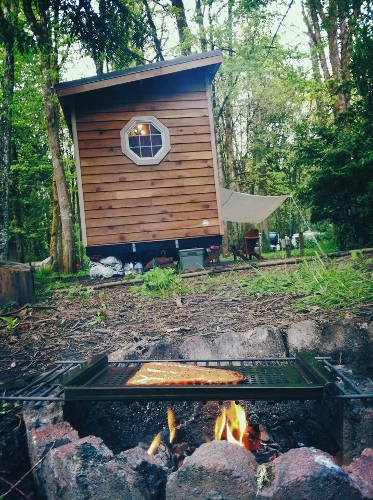Eating Small: How to Cook in a Tiny House Kitchen
Photos by Heather Morgan
When Heather Morgan and her family moved into a tiny house, they not only downsized their square-footage, but their fridge space as well. She, her husband Zach, and their two daughters are now eating out of a dorm-style mini-fridge—and absolutely loving it, although it has changed the ways in which the family purchases, stores and cooks food.
When the Morgans first married, they moved into a 900 square foot apartment in Louisiana, which soon filled up with their combined belongings. This was followed by similar experiences in increasingly larger homes, as they—both Zach and Amy were enlisted—moved with the Army.
Along the way, Heather became enamored with the tiny house concept, which was just becoming popular on minimalistic-lifestyle blogs and Pinterest. The square footage for a house to be considered a “tiny house” is debated, but the typical tiny home falls between 100 and 400 square feet, compared to the average US home size of 2,600 square feet. Heather liked the idea of downsizing, but after having her first daughter—and seeing how much space their current belongings took up—the tiny house just stayed a dream.
However, while deployed to Afghanistan, Heather lived in a 8-foot by 25-foot containerized housing unit, of which Heather only used about a third. “And it was at that point that I realized, ‘You know, we could do this!’” Heather said.
The family had a specialized builder in Washington create a custom tiny house. It came in around 300 square feet and was built on wheels so they could transport it easily in the case of another transfer, which is how the Morgans ended up across the country at a campground by Elkhorn Creek, right outside of Frankfort, Kentucky.
There are a now a number of builders—like the one the Morgans used—who focus exclusively on “building tiny.” For example Dan Louche, the founder of Tiny Home Builders. He says there are plenty of ways to ease the transition from normal-sized homes, especially in the kitchen where people have a distinct idea of what they want in that space.
“The biggest thing that I encourage people to do is invest in appliances that can be put away when they aren’t being used so as not to clutter the countertops,” Louche explained. “My mom actually lives in a tiny house, the very first one I ever built, and I got her an induction cooktop that she could store when it wasn’t in use.”
Another important tip for those looking to downsize is learning how to effectively use all available storage space. “An example just off the top of my head is a recent house we designed with stairs leading up to the sleeping loft,” Louch continued. “In most normal houses that space underneath the stairs would either be nothing, or just a small closet, however in this one, the entire area under the steps was pantry storage.”
The Morgans utilized these tips and more in their quest to go tiny. Here are some ways that cooking in a new home has been different than in a regular-sized kitchen.

On Food Storage
-

-

-

-

-

-

-

-

-

-

-

-

-

-

-

-

-

-

-

-

-

-

-

-

-

-

-

-

-

-

-

-

-

-

-

-

-

-

-

-









































